[sam_pro id=”1_45″ codes=”true”]

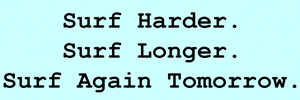


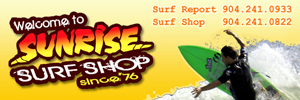
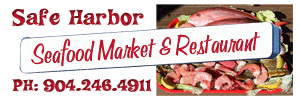


The holidays are a time for family, friends and reflection. Reflecting on the good times, as well as the bad times, keeps us connected to life  and each other. It’s also a time to reflect on who gives us the earth, ocean, sky and then superimposes the complexity of weather on all of it. The Giver inspires us to give each other gifts and surfing is a gift that the Giver keeps on giving. Even when it’s flat, we know the next gift is on its way.
and each other. It’s also a time to reflect on who gives us the earth, ocean, sky and then superimposes the complexity of weather on all of it. The Giver inspires us to give each other gifts and surfing is a gift that the Giver keeps on giving. Even when it’s flat, we know the next gift is on its way.
We can all reflect back to when we were first given the gift of surfing…that first board, that first time to stand up, that first barrel, that first surf trip. This short story from The Inertia is about a Persian musician, who was given the gift of surfing and the rest is predictable. Please share it as a gift to your social network…
‘As I paddled back out towards the lineup, I focused on each stroke, pushing through the strong current and relentless waves. The water was warm and the sun began to slowly break through the checkered clouds in the sky, illuminating the calm water beyond the surf. As a wave formed in front of me, I looked up to see a familiar figure moving into position on his nine-foot, custom-made longboard. He paddled with intensity, momentarily paused, and stood up on a chest-high, near-perfect wave. As I went over the wave I looked to my left to watch Mike as he smoothly dropped in, went right, and effortlessly maneuvered around surfers while maintaining complete composure and style. It dawned on me then that one of the best parts about surfing is watching your friends surf. Several minutes later, Mike’s voice yelled out behind me, “Dave, you know I’m going to give you the biggest hug right now!” He grinned, paddled within two feet of where I sat on my board, and lunged through the air, effectively tackling me into the water.
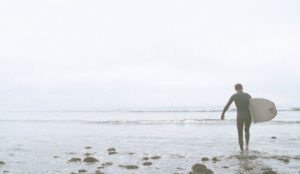 Five years ago, on June 22nd, 2012, I gave Mike his first proper introduction to surfing. Since then, on every single subsequent June 22nd, without fail, Mike reminds me that on that particular day his life was forever changed. This, understandably, puts me in an awkward position. Surfing, after all, is just that, and hyperbole is too often used in the description of surfing. I agree that some parts of his life have changed. For instance, Mike now buys surfboards, he has extensive knowledge about local breaks near his home, and he can now point out obscure, professional longboarders in the water when we surf. Five years ago all of that was foreign territory. But on a deeper, meaningful way regarding his life being changed, I tell Mike, no, no it did not change your life. Nonetheless, he will argue his claim with great fervor until the day he dies.
Five years ago, on June 22nd, 2012, I gave Mike his first proper introduction to surfing. Since then, on every single subsequent June 22nd, without fail, Mike reminds me that on that particular day his life was forever changed. This, understandably, puts me in an awkward position. Surfing, after all, is just that, and hyperbole is too often used in the description of surfing. I agree that some parts of his life have changed. For instance, Mike now buys surfboards, he has extensive knowledge about local breaks near his home, and he can now point out obscure, professional longboarders in the water when we surf. Five years ago all of that was foreign territory. But on a deeper, meaningful way regarding his life being changed, I tell Mike, no, no it did not change your life. Nonetheless, he will argue his claim with great fervor until the day he dies.
I met Mike when I worked at the music store where he teaches piano. Through various conversations, he learned that I was a fairly dedicated surfer. Mike, like many adults, had sort of tried to surf once many years ago, but it had not gone very well. They often fail and find the whole experience rather frustrating, chalking it up to being “old”—simply unable to learn new tricks. The thought of surfing, the exhilaration and adventure, intrigued him, however. Mike admitted that through his life his contact with the ocean, let alone the outdoors in general, has been extremely limited, and he had certain reservations about the dangers that surfing can present. When I asked him about any sports or hiking or snowboarding he may have participated in he shook his head. “No. I didn’t play outside much as a kid. I’m pretty sure I’m allergic to everything now because of that,” he said.
Mike has dedicated his entire adult life to music. He can explain complicated, abstract music theory while simultaneously playing a Rachmaninoff piece, yet he would state that he might likely drown while attempting to swim a few laps in a pool. Through his self-deprecation, it did become clear that Mike’s central focus in his life had, in turn, eliminated other areas that he, in theory, might be interested in. The majority of his life, from what I gathered, had been spent in a somewhat sedentary, largely indoor manner.
“Plus,” he told me once, “I’m Persian. We don’t surf.”
So, in June of 2012, he surfed. Mike, along with a few others from the music store and a close friend of mine, joined me one morning at T-street, a somewhat mushy, inconsistent, and beloved break in San Clemente.
T-street is a messy mosaic of nearly every kind of ocean-based activity. You find beginners paddling out on fresh Wavestorms—theirreceipts from Costco still in the pockets of their bright, floral-patterned board shorts—while local pros like Kolohe Andino throw clean air reverses out of closeouts and whatever else the break can manage to cough up. It can be a gritty, unpredictable wave with quirky characteristics that differ even within 50 yards left and right of the main point. Why I would bring someone here to truly experience surfing for the first time, I cannot say. With gentler, beginner favorites in Orange County like Doheny, Blackies, and San Onofre, I would be lying if I said I didn’t have solid options to introduce Mike and my other coworkers to a more user-friendly wave.
Perhaps I took this group of beginners to T-Street because it was there where I myself first truly immersed myself in surfing. It was at T-Street I learned how to do turns, how to be comfortable around large groups of wave-hungry locals, and where I learned to be assertive and 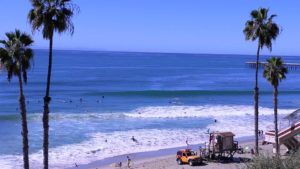 confident in finding waves. It was also where I experienced real fear for the first time in the ocean, paddling out into eight-to-ten foot stormy, walled-out surf, with only one other soul in the water to keep my 16-year-old self company. I didn’t learn how to surf at T-street, but I learned how to become a surfer at T-street.
confident in finding waves. It was also where I experienced real fear for the first time in the ocean, paddling out into eight-to-ten foot stormy, walled-out surf, with only one other soul in the water to keep my 16-year-old self company. I didn’t learn how to surf at T-street, but I learned how to become a surfer at T-street.
That morning on June 22, 2012, we all met on the street in front of the set of stairs that lead down to the sand. Out of the four that joined me that morning, Mike was the only one who didn’t have a board. Each of the others managed to bring something resembling a surfboard— likely belonging to someone else in their family— that they found in their garage, collecting cobwebs, unused for years—a waterlogged artifact at this point. I brought Mike a foam board and assured him that it would be more than adequate and, in fact, ideal in serving as an introduction to surfing.
I tried to stay around Mike most of the time that morning, and I watched him struggle in nearly all aspects. I did my best to offer advice and tips and I later ditched my own surfboard on the sand in order to better push my friends into some of the waves. Mike looked awkward paddling, he uncomfortably watched the waves pass by, and more than once, he went underwater in feeble attempts to catch some of the smaller scraps closer to shore. He did nosedives. His board slipped out from under him. He swallowed too much water. I tried not to laugh; I tried to remain positive. As a beginner, Mike would most definitely struggle in the early stages, but I expected this. The unsteadiness on the board, the thrashing under the waves, the water up the nose—these were simply the minor discomforts that I knew Mike would have to face and conquer early on if he wanted to be a surfer.
Mike didn’t spend his childhood or formative years in the ocean. Basic knowledge that I took for granted was unknown to him and the overall experience of not only surfing but confidently existing in the water was an entirely new concept to Mike. I recall offering some advice on the sand before we set off to surf.
“You’re going to want to paddle, hard, until you feel the wave sort of pick you up or push you,” I said. Mike looked at me blankly.
“What does that mean?” he asked.
“Okay, so you know how when you’re boogie boarding you feel the wave carry you? And then it launches you to shore?” I asked, offering a different solution. He again looked confused.
“I’ve never boogie boarded,” Mike replied.
“Okay, so you know how when you’re body surfing…” I stopped myself, remembering the extent of Mike’s ocean-related experience.
I told him not to worry about it, to forget what I was saying, and he’ll figure it out on the water. In hindsight, the “learn out on the water” teaching method is not one I recommend, but regardless, I believe Mike came out of that first day stronger, if not a little more bruised by it.
Later when we regrouped, I tried to get a sense of how it went for everyone. Mike looked tired but rather astonished by what he just did. More importantly, he was smiling. I can’t speak for Mike regarding how he felt that day and every following day of surfing; I can only describe what I saw. I witnessed energy, joy, confidence, and a spark. I observed in Mike the childlike wonder and amusement that comes with experiencing surfing for the first time, and sadly, you only get that pure moment once. But I knew he was hooked.
Currently, Mike surfs at least twenty times as often I do. He watches surf videos and speaks with excruciating detail about how he plans to master certain maneuvers. He talks surf forecasting in a scientific, professional manner—something I’ve personally never had the patience to fully understand. He’s taught more people how to surf in the past five years than I can count. Mike, more than anyone I know, understands just how contagious surfing can be, and time after time goes out of his way to help someone get started if they are interested.
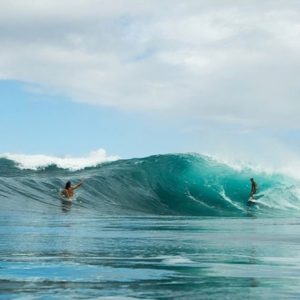 Sometimes I worry I’ve created a monster and that he’ll succumb to the (insufferable) surfer stereotype we are all too familiar with. I wonder if he’ll buy a van, sell his unnecessary possessions, and drive from break to break, surfing with each sunrise and sunset. But he never will. That is not the point of surfing for Mike. It is not to distance himself from others, completely absorbed in his own world. Surfing allows him to fully and joyfully embrace other aspects of his life. His work, his music, his friendships are all enhanced by this one pursuit. It adds adventure and curiosity, excitement and fear, passion and beauty to a world that can more often than not feel mundane and cold.
Sometimes I worry I’ve created a monster and that he’ll succumb to the (insufferable) surfer stereotype we are all too familiar with. I wonder if he’ll buy a van, sell his unnecessary possessions, and drive from break to break, surfing with each sunrise and sunset. But he never will. That is not the point of surfing for Mike. It is not to distance himself from others, completely absorbed in his own world. Surfing allows him to fully and joyfully embrace other aspects of his life. His work, his music, his friendships are all enhanced by this one pursuit. It adds adventure and curiosity, excitement and fear, passion and beauty to a world that can more often than not feel mundane and cold.
The last time I went surfing with Mike it was on a Saturday afternoon with solid, chest to head high waves. It was crowded and the wind was beginning to pick up, so after an hour or so we headed in. We drank a couple of beers and I listened to him describe some of the better waves he caught. I was happy to hear the excitement in his voice and his eagerness to further advance as a surfer. Of course, when I watch Mike surf I’m impressed by the progress he has made in his skill level, but truth be told, I don’t care too much about that. I do care, however, that five years ago Mike tried something new—unabashed and at the mercy of the ocean. He entirely embraced something out of his element and he couldn’t have asked for better results. Mike will tell you that five years ago his life was changed; but more importantly, he might just say these past five years have been some of the greatest of his life.’

Keep giving, keep your edge…
Speaking of gifts, check out Bruce Brown’s classic ‘Surfing Hollow Days’ (below)…
Bruce Brown was, of course, best known for The Endless Summer, but he made far more movies than just that. Among his other classics is Surfing Hollow Days, which includes the first surfing footage of Pipeline ever shot.
Read about Bruce Brown’s life here, then come back and watch Surfing Hollow Days in its entirety with a wonderful intro by the man himself.






